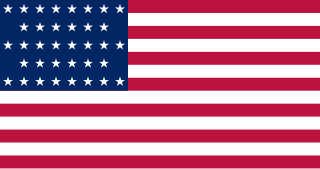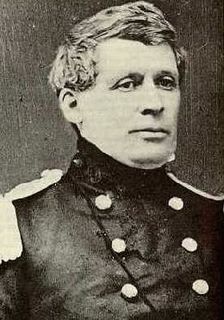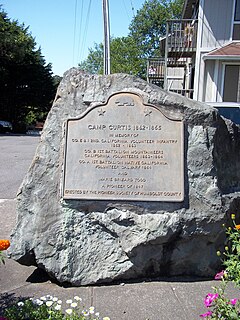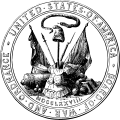The Snake War (1864–1868) was an irregular war fought by the United States of America against the "Snake Indians," the settlers' term for Northern Paiute, Bannock and Western Shoshone bands who lived along the Snake River. Fighting took place in the states of Oregon, Nevada, and California, and in Idaho Territory. Total casualties from both sides of the conflict numbered 1,762 dead, wounded, or captured.
The Department of the Pacific or Pacific Department was a major command (Department) of the United States Army from 1853 to 1858. It replaced the Pacific Division, and was itself replaced by the Department of California and the Department of Oregon.

California's involvement in the American Civil War included sending gold east to support the war effort, recruiting volunteer combat units to replace regular U.S. Army units sent east, in the area west of the Rocky Mountains, maintaining and building numerous camps and fortifications, suppressing secessionist activity and securing the New Mexico Territory against the Confederacy. The State of California did not send its units east, but many citizens traveled east and joined the Union Army there, some of whom became famous.

The First Regiment Oregon volunteer Cavalry was a volunteer regiment in United States service Union army that was formed in response to the American Civil War. With men recruited in Oregon and some recruited in surrounding states, the regiment primarily served to protect the state of Oregon and surrounding territories during the American Civil War.
The Pacific coast theater of the American Civil War consists of major military operations in the United States on the Pacific Ocean and in the states and Territories west of the Continental Divide. The theater was encompassed by the Department of the Pacific that included the states of California, Oregon, and Nevada, the territories of Washington, Utah, and later Idaho.

The 4th California Infantry was a volunteer infantry regiment recruited from northern California during the American Civil War. It was organized at Sacramento, Placerville, and Auburn in September and October 1861.

George Wright was an American soldier who served in the Mexican–American War and the American Civil War.
During the American Civil War, Army reorganization created the Department of the Pacific on January 15, 1861. On December 12, 1861, the District of Humboldt was created, consisting of the counties of Sonoma, Napa, Mendocino, Trinity, Humboldt, Klamath, and Del Norte in Northern California. The district was headquartered at Fort Humboldt, located on a bluff above the central portion of Humboldt Bay south of Eureka, California, which is now a California State Historic Park located within the City of Eureka. The District's efforts were directed at prosecuting the ongoing Bald Hills War against the Indians in the northern, coastal area of the large district. A peace was achieved in August 1864.
The District of Southern California was a nineteenth century district of Department of the Pacific, a command of the United States Army.

The District of Oregon was a Union Army command department formed during the American Civil War.

The 2nd Regiment California Volunteer Infantry was an infantry regiment in the Union Army during the American Civil War. It spent its entire term of service in the western United States. Organized at San Francisco and Carson City September 2, 1861, to December 30, 1862, and attached to Department of the Pacific. The regiment was first assembled at the Presidio, San Francisco, and after completing its organization, five companies were sent to Oregon and Washington Territory, to relieve the regular troops, and two companies were sent to Santa Barbara. The troops of this regiment sent to Oregon were afterwards returned to California. It was mustered out during the month of October, 1864.
During the American Civil War in the early 1860s, the District of Utah was a subordinate district of the U.S. Army's Department of the Pacific. The district was composed of territorial areas that later became parts of the modern U.S. states of Idaho, Nevada, and Utah.
The Department of New Mexico was a department of the United States Army during the mid-19th century. It was created as the 9th Department, a geographical department, in 1848 following the successful conclusion of the Mexican–American War, and renamed Department of New Mexico in 1853. It had to contend with an invading Confederate force during the New Mexico Campaign of the American Civil War from mid-1861 to early 1862, then with Apache tribes during the remainder of the conflict. It was merged into the Department of California after the end of the war as the District of New Mexico.
District of Arizona was a subordinate district of the Department of New Mexico territory created on August 30, 1862 and transferred to the Department of the Pacific in March 1865.

1st Battalion California Volunteer Mountaineers was an infantry battalion in the Union Army during the American Civil War. It spent its entire term of service in the western United States, attached to the Department of the Pacific. It was organized from men from the counties of Humboldt, Mendocino, Trinity, Klamath, Siskiyou, and Del Norte, and other parts of California, between May 30, 1863, and March 16, 1864, for special service in the redwood forests and mountains that was being fought over in the Bald Hills War in Humboldt County within the Humboldt Military District. The Battalion mustered out June 14, 1865.

The Department of California was an administrative department of the United States Army. The Department was created in 1858, replacing the original Department of the Pacific, and it was ended by the reorganizations of the Henry L. Stimson Plan implemented in February 1913. As with the preceding organization, headquarters were in San Francisco. Its creation was authorized by General Orders, No. 10, of the War Department, Adjutant-General's Office, September 13, 1858.
The Department of the Columbia was a major command (Department) of the United States Army during the 19th century.
During the American Civil War, a department was a geographical command within the Union's military organization, usually reporting directly to the War Department. Many of the Union's departments were named after rivers or other bodies of water, such as the Department of the Potomac and the Department of the Tennessee. The geographical boundaries of such departments changed frequently, as did their names. As the armies became larger Departments began to be subordinated to Military Divisions, and the Departments were often sub divided into Districts and from 1862 Subdistricts. Much information on Civil War departments can be found in Eicher & Eicher, Civil War High Commands.
The Department of Arizona was a military department of the United States Army that existed from 1870 to 1893. It was subordinate to the Military Division of the Pacific and comprised posts in Arizona and Southern California. It was the successor to the District of Arizona within the Department of California. It was headquartered at Drum Barracks in Wilmington, California.
The District of New Mexico was a military district of the United States Army in the Territory of New Mexico that existed from 1865 to 1890. The District of Arizona and the District of New Mexico replaced the Department of New Mexico from June 27, 1865.








